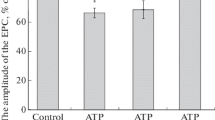Abstract
The neuromuscular junction of amphibians (lake frogs) was studied in a calcium-free medium. It is known that the activation of voltage-dependent calcium channels is necessary to initiate the release of neurotransmitter into the synaptic cleft. In our initial experiments, we demonstrated depression of evoked postsynaptic responses up to complete disappearance in a calcium-free environment, as described by many authors. In our experiments, when Ringer’s solution containing a normal ionic content of Ca2+ was replaced with a calcium-free Ringer that had an equimolar content of Ba2+, the amplitude of the end plate currents decreased by a factor of more than ten, although remaining at the same level during the entire observation time for more than 1 h. Then, caffeine, that can initiate calcium release from ryanodine-sensitive Ca2+ stores, was used to deplete these intracellular Ca2+ stores. After administration (and wash-out) of 100 μM caffeine, the evoked responses in a barium-only medium resumed (in a specific, overextended, irregular form) only under conditions for prolonging the action potential of the nerve ending by applying 4-aminopyridine at a concentration of 100 μM, and only for the first few minutes. Subsequently, the evoked currents were blocked, only “flashes” of miniature postsynaptic currents were seen in response to each stimulation. In this work, we have confirmed the fundamental possibility of neuromuscular junction activation by barium ions under very specific experimental conditions.

Similar content being viewed by others
REFERENCES
M. A. Mukhamedyarov, S. N. Grishin, A. L. Zefirov, and A. Palotas, Pflügers Arch. 458, 563 (2009).
P. G. Kostyuk, Calcium and cellular excitability (Nauka, Moscow, 1986) [in Russian].
S. N. Grishin, Calcium Current (Kazan. Nats. Issled. Technol. Univ., Kazan, 2010) [in Russian].
T. Ohno-Shosaku, S. Sawada, K. Hirata, and C. Yamamoto, Neurosci. Res. 20, 223 (1994).
H. Helmholtz, Ann. Phys. Chem. 165, 211 (1853).
M. Gouy, J. Phys. Theor. Appl. 9, 457 (1910).
D. L. Chapman, Philos. Mag. J. Sci. 25, 475 (1913).
O. Z. Stern, Electrochemistry 30, 508 (1924).
P. G. Kostyuk, Neuroscience 92 (4), 1157 (1999).
G. Cota and E. Stefani, J. Physiol. 351, 135 (1984).
L. Tang, T. M. Gamal El-Din, J. Payandeh, et al., Nature 505 (7481), 56 (2014).
F. Neumaier, M. Dibué-Adjei, J. Hescheler, and T. Schneider, Prog. Neurobiol. 129, 1 (2015).
B. Katz and R. Miledi, J. Physiol. 203, 459 (1969).
D. A. Nachshen and M. P. Blaustein, J. Gen. Physiol. 79, 1065 (1982).
H. D. Lux and K. Nagy, Pflügers Arch. 391, 252 (1981).
R. DiPolo, C. Caputo, and F. Bezanilla, Proc. Natl. Acad. Sci. U. S. A. 80, 1743 (1983).
D. Tillotson, Proc. Natl. Acad. Sci. U. S. A. 76, 1497 (1979).
P. Brehm, R. Eckert, and D. Tillotson, J. Physiol. 306, 193 (1980).
R. Eckert and D. L. Tillotson, J. Physiol. 314, 265 (1981).
A. M. Brown, K. Morimoto, Y. Tsuda, and D. L. Wilson, J. Physiol. 320, 193 (1981).
S. N. Grishin, Biochemistry (Moscow), Suppl. Ser. A: Membr. Cell Biol. 8, 213 (2014).
M. A. Mukhamedyarov, S. N. Grishin, A. L. Zefirov, and A. Palotas, Brain Res. Bull. 69, 652 (2006).
A. U. Ziganshin, A. E. Khairullin, C. H. V. Hoyle, and S. N. Grishin, Int. J. Mol. Sci. 21, 6423 (2020).
P. Fatt and B. Katz, Cold Spring Harbor Symp. Quant. Biol. 17, 275 (1952).
J. Del Castillo and B. Katz, J. Physiol. 124, 553 (1954).
Z. L. Blioch, I. M. Glagoleva, E. A. Liberman, and V. A. Nenashev, J. Physiol. 199, 11 (1968).
A. W. Liley, J. Physiol. 134, 427 (1956).
J. I. Hubbard, J. Physiol. 159, 507 (1961).
D. Elmqvist and D. S. Feldman, J. Physiol. 181, 487 (1965).
R. Anwyl, T. Kelly, and F. Sweeney, Brain Res. 246, 127 (1982).
M. J. Curtis, D. M. Quastel, and D. A. Saint, J. Physiol. 373, 243 (1986).
S. N. Grishin, Biochemistry (Moscow), Suppl. Ser. A: Membr. Cell Biol. 10, 99 (2016).
P. Fatt and B. Katz, J. Physiol. 111, 46 (1950).
E. M. Silinsky, Br. J. Pharmacol. 59, 215 (1977).
I. S. Magura, J. Membr. Biol. 35, 239 (1977).
G. Neves, A. Neef, and L. Lagnado, J. Physiol. 535, 809 (2001).
A. L. Zefirov and P. N. Grigor’ev, Neurosci. Behav. Physiol. 40, 389 (2010).
Author information
Authors and Affiliations
Corresponding author
Ethics declarations
Conflict of interest. The authors declare that they have no conflicts of interest.
Statement on the welfare of animals. All applicable international, national, and/or institutional guidelines for the care and use of animals were followed.
Additional information
Translated by P. Kuchina
Abbreviations: EPC, end plate currents.
Rights and permissions
About this article
Cite this article
Grishin, S.N., Khairullin, A.E., Teplov, A.Y. et al. Neuromuscular Transmission in a Barium Environment. BIOPHYSICS 67, 457–460 (2022). https://doi.org/10.1134/S000635092203006X
Received:
Revised:
Accepted:
Published:
Issue Date:
DOI: https://doi.org/10.1134/S000635092203006X



